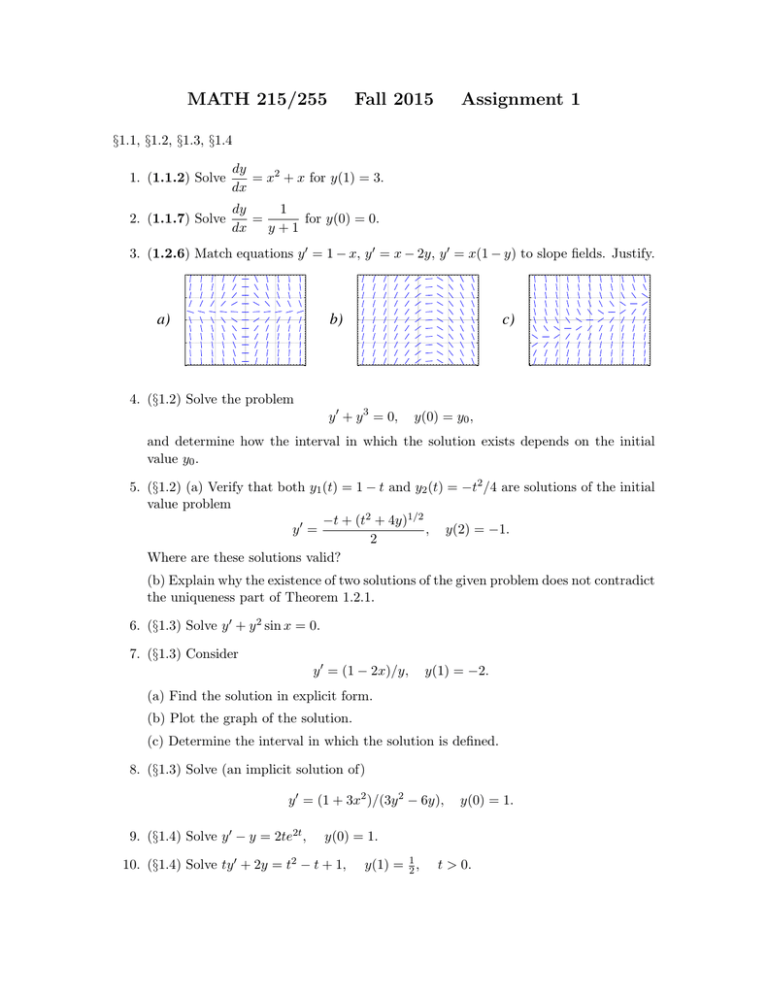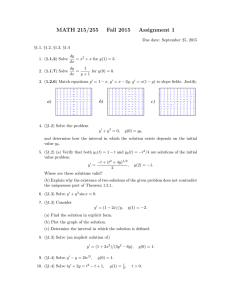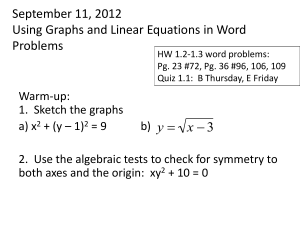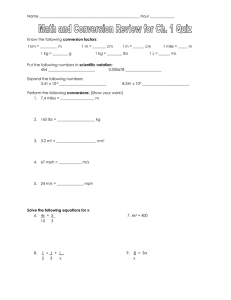1.2. SLOPE FIELDS 21
advertisement

For most of this course we will be interested in equations where existence and uniqueness holds and in fact holds “globally” unlike for the equation y0 = y2 . 1.2.3 Exercises Exercise 1.2.1: Sketch slope field for y0 = e x y . How do the solutions behave as x grows? Can you MATH 215/255 Fall 2015 Assignment 1 guess a particular solution by looking at the slope field? Exercise 1.2.2: Sketch slope field for y0 = x2 . §1.1, §1.2, §1.3, §1.4 Exercise 1.2.3: Sketch slope field for y0 = y2 . dy 1. (1.1.2) Solve = x2 + x for y(1) = 3. Exercise 1.2.4: dx Is it possible to solve the equation y0 = xy cos x p for y(0) = 1? Justify. dy Is it1 possible to solve the equation y0 = y |x| for y(0) = 0? Is the solution unique? Exercise 1.2.5: = for y(0) = 0. 2. (1.1.7) Solve dx y+1 Justify. 0 = 1 − x, y 0 0= x − 2y, y 00 = x(1 − y) to 3. (1.2.6) Match equations Exercise 1.2.6: Matchyequations y = 1 x, y = x 2y, y0 =slope x(1 fields. y) toJustify. slope fields. Justify. a) b) c) Exercise 1.2.7 (challenging): Take y0 = f (x, y), y(0) = 0, where f (x, y) > 1 for all x and y. If the 4. (§1.2) Solve the problem solution exists for all x, can you say what happens to y(x) as x goes to positive infinity? Explain. 0 3 y + y = 0, y(0) = y0 , Exercise 1.2.8 (challenging): Take (y x)y0 = 0, y(0) = 0. a) Find two distinct solutions. b) Explain and determine how the interval in which the solution exists depends on the initial why this does not violate Picard’s theorem. value y . 0 Exercise 1.2.101: Sketch the slope field of y0 = y3 . Can you visually find the solution that satisfies 5. (§1.2) (a) Verify that both y1 (t) = 1 − t and y2 (t) = −t2 /4 are solutions of the initial y(0) = 0? value problem 2 + 4y)1/20 −t + (tto Exercise 1.2.102: Is it0 possible solve y = xy for y(0) = 0? Is the solution unique? y = , Exercise 1.2.103: Is it possible to2solve y0 = Where are these solutions valid? y(2) = −1. x x2 1 0 for y(1) = 0? Exercise 1.2.104: Match equations y0 = sin x, y = cos y, y0 = y cos(x) to slope fields. Justify. (b) Explain why the existence of two solutions of the given problem does not contradict the uniqueness part of Theorem 1.2.1. 6. (§1.3) Solve y 0 + y 2 sin x = 0. a) b) c) 7. (§1.3) Consider y 0 = (1 − 2x)/y, y(1) = −2. (a) Find the solution in explicit form. (b) Plot the graph of the solution. (c) Determine the interval in which the solution is defined. 8. (§1.3) Solve (an implicit solution of) y 0 = (1 + 3x2 )/(3y 2 − 6y), 9. (§1.4) Solve y 0 − y = 2te2t , y(0) = 1. y(0) = 1. 10. (§1.4) Solve ty 0 + 2y = t2 − t + 1, y(1) = 12 , t > 0. 11. (§1.4) Find the value of y0 for which the solution of the initial value problem y 0 − y = 1 + 3 sin t, y(0) = y0 remains finite as t → ∞ (i.e., uniformly bounded by some constant for all t). 12. (§1.4) A tank initially contains 120 L of pure water. A mixture containing a concentration of γ g/L of salt enters the tank at a rate of 2 L/min, and the well-stirred mixture leaves the tank at the same rate. Find an expression in terms of γ for the amount of salt in the tank at any time t. Also find the limiting amount of salt in the tank as t → ∞. 2






